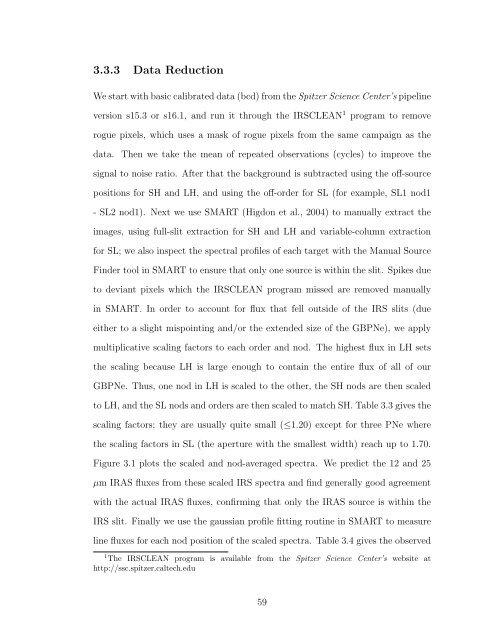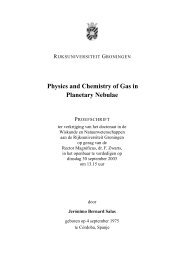TRACING ABUNDANCES IN GALAXIES WITH THE SPITZER ...
TRACING ABUNDANCES IN GALAXIES WITH THE SPITZER ...
TRACING ABUNDANCES IN GALAXIES WITH THE SPITZER ...
Create successful ePaper yourself
Turn your PDF publications into a flip-book with our unique Google optimized e-Paper software.
3.3.3 Data Reduction<br />
We start with basic calibrated data (bcd) from the Spitzer Science Center’s pipeline<br />
version s15.3 or s16.1, and run it through the IRSCLEAN 1 program to remove<br />
rogue pixels, which uses a mask of rogue pixels from the same campaign as the<br />
data. Then we take the mean of repeated observations (cycles) to improve the<br />
signal to noise ratio. After that the background is subtracted using the off-source<br />
positions for SH and LH, and using the off-order for SL (for example, SL1 nod1<br />
- SL2 nod1). Next we use SMART (Higdon et al., 2004) to manually extract the<br />
images, using full-slit extraction for SH and LH and variable-column extraction<br />
for SL; we also inspect the spectral profiles of each target with the Manual Source<br />
Finder tool in SMART to ensure that only one source is within the slit. Spikes due<br />
to deviant pixels which the IRSCLEAN program missed are removed manually<br />
in SMART. In order to account for flux that fell outside of the IRS slits (due<br />
either to a slight mispointing and/or the extended size of the GBPNe), we apply<br />
multiplicative scaling factors to each order and nod. The highest flux in LH sets<br />
the scaling because LH is large enough to contain the entire flux of all of our<br />
GBPNe. Thus, one nod in LH is scaled to the other, the SH nods are then scaled<br />
to LH, and the SL nods and orders are then scaled to match SH. Table 3.3 gives the<br />
scaling factors; they are usually quite small (≤1.20) except for three PNe where<br />
the scaling factors in SL (the aperture with the smallest width) reach up to 1.70.<br />
Figure 3.1 plots the scaled and nod-averaged spectra. We predict the 12 and 25<br />
µm IRAS fluxes from these scaled IRS spectra and find generally good agreement<br />
with the actual IRAS fluxes, confirming that only the IRAS source is within the<br />
IRS slit. Finally we use the gaussian profile fitting routine in SMART to measure<br />
line fluxes for each nod position of the scaled spectra. Table 3.4 gives the observed<br />
1 The IRSCLEAN program is available from the Spitzer Science Center’s website at<br />
http://ssc.spitzer.caltech.edu<br />
59













